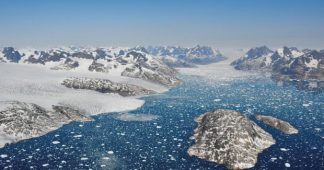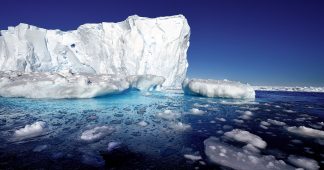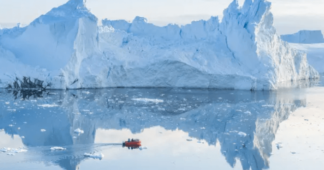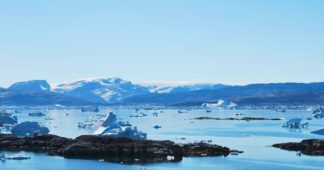No longer can any rational person claim that climate change isn’t happening. Instead, the new deniers argue that people will be able to adapt to climate chaos and that swift, decisive action is “magical thinking.”
By Olivia Riggio*
“Yes, Greenland’s Ice Is Melting…”
The headline of the interactive New York Times opinion piece (10/28/22) by conservative columnist Bret Stephens is placed over an image of Greenland’s melting ice cap crashing into the slushy meltwater below. With one more scroll, the word “But…” appears over the ice, which resembles a melting snowplowed slush pile in a parking lot.
From just a glance at the headline, it was clear where this article was going. The 6,000-word piece went on to chronicle Stephens’ trip to Greenland as a self-proclaimed global warming “agnostic.” There, the dramatic effects of climate change “changed [his] mind” about the problem, but reinforced his “belief that markets, not government, provide the cure.”
Stephens’ point of view represents a new climate denialism: No longer can any rational person claim that climate change isn’t happening at an accelerated rate due to human causes, or that it’s not causing harm. Instead they argue, like Stephens, that the swift, decisive action scientists say is necessary is “magical thinking,” that genuine existential fear is “alarmist,” that most humans will be able to adapt to climate disaster.
In a nutshell, the new climate deniers say, “Yes, the climate is changing at an alarming rate, but the solution lies here in the status quo.”
Same data, opposite headlines
That same week, the New York Times served up two conflicting headlines. “Climate Pledges Are Falling Short, and a Chaotic Future Looks More Like Reality” (10/26/22) featured an image of a displaced Somali woman and her three young children, playing amid carcasses of cattle killed by the drought in the region this spring.
The front-page piece by reporter Max Bearak began:
Countries around the world are failing to live up to their commitments to fight climate change, pointing Earth toward a future marked by more intense flooding, wildfires, drought, heat waves and species extinction, according to a report issued Wednesday by the United Nations.
The article went on to explain that the planet is on track to warm 2.1–2.9 degrees Celsius from pre-industrial levels by 2100. The goal set at the 2015 Paris agreement was 1.5 degrees, above which scientists warn the risk for serious climate impacts increases.
Yet one day later, the Times‘ popular newsletter the Morning—read by millions every day—carried the subject line, “The Climate’s Improved Future” (10/27/22). The data cited in the newsletter by Times reporter German Lopez is no different than that in the dire news article published the day before: The Earth is likely to warm by 2–3 degrees Celsius by 2100, well above the target scientists have said would be relatively safe.
The difference is that Lopez was summarizing a new David Wallace-Wells cover story for the Times Magazine (10/26/22) that expressed the writer’s newfound optimism that the world won’t reach a worst-case scenario climate “doomsday” of 5 degrees of warming that he had explored five years earlier in a New York magazine piece (7/17). Wallace-Wells wrote:
The window of possible climate futures is narrowing, and as a result, we are getting a clearer sense of what’s to come: a new world, full of disruption but also billions of people, well past climate normal and yet mercifully short of true climate apocalypse.
Compared to five, of course, two to three degrees is better. But it’s important to keep in mind that the Earth’s temperature rising even by 1.5 degrees is still damaging. For context, in 2021 temperatures were about 1.1 degrees over the pre-industrial baseline (UN, 5/9/22).
In 2021, deadly heat waves spread across North America and the Mediterranean; cataclysmic floods devastated the European Union, China, India and Nepal; and sea levels hit record highs (World Economic Forum, 5/18/22; FAIR.org, 7/9/21, 7/22/21; US News, 12/23/21). With that 1.5-degree increase still to come, climate events around the world are already costing lives and livelihoods.
In the Morning, Lopez cited reasons for a possibly less catastrophic climate future: Coal is on the decline, renewable energy prices are dropping, and global powers are adopting policies to combat climate change. “Those countries include the United States, which recently enacted sweeping incentives for cleaner energy through the Inflation Reduction Act,” Lopez wrote.
It’s true, but just a day before, Bearak reported in the same outlet the following: “The new law will still only get the United States about 80% of the way to its current pledge to cut emissions.”
Once again, context matters.
Lopez was sure to note that “better does not mean good,” and that countries are falling short of their climate commitments. “Even under the most optimistic climate forecasting models, such extreme weather will get worse and become more common in the coming decades,” he wrote.
‘Manageable’ for the rich
Lopez concluded that “the takeaway is mixed”:
If you had asked a politically cynical person 30 years ago what the climate future looked like, they might have answered that we’d end up at a temperature level that was difficult but manageable for the rich countries of the world but much, much harder for developing nations. And that looks like what we’re heading for.
Continuing and worsening extreme weather making life “difficult but manageable” for rich nations and “much, much harder” for developing ones earns a headline celebrating the climate’s “improved future” at the New York Times, just a day after it warned (10/26/22):
With each fraction of a degree of warming, tens of millions more people worldwide would be exposed to life-threatening heat waves, food and water scarcity, and coastal flooding while millions more mammals, insects, birds and plants would disappear.
As climate justice activists have been saying for years, it is poor nations and individuals most affected by climate disaster. The centrality of the topic of “loss and damage” in the COP27 conference going on now further demonstrates this (Democracy Now!, 11/9/22).
An International Disaster Database report on the first half of 2022 lists the top 10 countries most impacted by natural disasters by number of deaths, number of people affected and economic damage, respectively. Every country on the “deaths” and “people affected” lists is in the Global South, and none are in Europe or the Americas.
Fossil fuel talking points
Not only are we headed for at least a 1.5-degree rise, but a new UN report from October 27 says there is currently no credible plan in place for nations to meet that goal. Current pledges put us at about a 2.5 degree Celsius rise by the end of the century.
Inger Andersen, the executive director of the UN Environment Program (UNEP), told the Guardian (10/27/22):
We had our chance to make incremental changes, but that time is over. Only a root-and-branch transformation of our economies and societies can save us from accelerating climate disaster.
Still, in his 6,000-word opinion feature, Stephens argues that the answer to the climate disaster lies in “the market” that got us here. As Judd Legum and Emily Atkin point out for Popular Information (11/3/22), the solution to capitalism’s problems being more capitalism is nothing more than a fossil fuel industry talking point.
So is the following:
Many people tend to think of fossil fuels mostly in terms of transportation, electrical generation and heating. But how often do we consider the necessity of fossil fuels in the production of nitrogen fertilizer, without which, [Canadian author Vaclav] Smil noted, “it would be impossible to feed at least 40% and up to 50% of today’s nearly 8 billion people”?
Stephens essentially argues that turning completely against fossil fuels is “against human nature,” and climate solutions thus far are all like a cancer treatment with painful side effects.
OK, let’s go with that metaphor: If current solutions are like chemotherapy for lung cancer, then fossil fuels are like cigarettes. You don’t keep feeding cigarettes to someone who is undergoing cancer treatment. It would be absurd to suggest that cigarettes were a necessary stopgap in treating cancer.
When the fossil fuel–friendly New York Times publishes arguments like Stephens’, and plays volleyball with whether or not the same climate data is horrifying or reassuring, it helps confuse the public and keep us complacent—and complicit. It’s this corporate propaganda—not “human nature”—that keeps our culture from making the shifts necessary to avoid an unpredictable and deadly future.
We remind our readers that publication of articles on our site does not mean that we agree with what is written. Our policy is to publish anything which we consider of interest, so as to assist our readers in forming their opinions. Sometimes we even publish articles with which we totally disagree, since we believe it is important for our readers to be informed on as wide a spectrum of views as possible.











